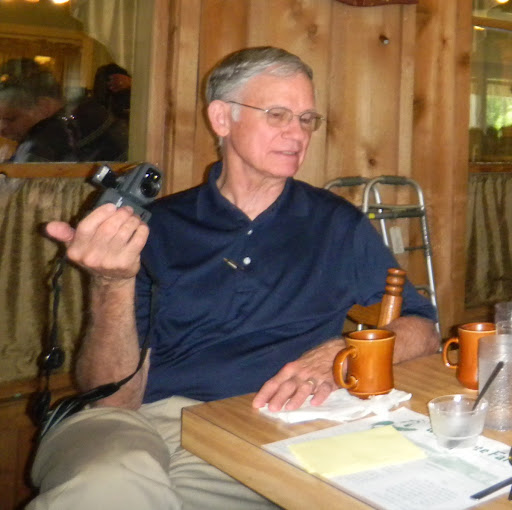Donald J Macgregor
Deceased
from Manasquan, NJ
- Also known as:
-
- Donalde J Macgregor
Donald Macgregor Phones & Addresses
- Manasquan, NJ
- Brooklyn, NY
- Spotswood, NJ
Resumes

Consultant Paediatrician At Nhs Tayside
view sourceLocation:
Perth, United Kingdom
Industry:
Medical Practice

Donald Wayne Macgregor
view source
Donald Macgregor
view source
Donald Macgregor
view source
Management Consultant
view sourceLocation:
Glasgow, United Kingdom
Industry:
Mechanical or Industrial Engineering
Us Patents
-
Precision Press Brake
view source -
US Patent:50673408, Nov 26, 1991
-
Filed:May 3, 1989
-
Appl. No.:7/345675
-
Inventors:Donald C. MacGregor - Warren NJ
-
International Classification:B21D 501
-
US Classification:72389
-
Abstract:A bending press comprising a lower frame member, an upper frame member mounted above the lower frame member, tool holding means positioned in operative association with one of the frame members for holding bending tool means, die holding means positioned in operative association with the other of the frame members for holding die means, a plurality of first hydraulic rams mounted in laterally spaced relationship to be operative between the tool holding means and the associated frame member, a plurality of second hydraulic rams mounted in laterally spaced relationship to be operative between the die holding means and the associated frame member, the first hydraulic rams being adapted to be hydraulically connected together during use for hydraulic fluid to distribute a load applied to a workpiece during use evenly between the first hydraulic rams and provide compensation for frame member deflection during use, and the second hydraulic rams being adapted to be hydraulically connected together during use for hydraulic fluid to distribute a load applied to a workpiece during use evenly between the second hydraulic rams and provide compensation from frame member deflection during use.
-
Fuel Treatment Device
view source -
US Patent:51541530, Oct 13, 1992
-
Filed:Sep 13, 1991
-
Appl. No.:7/591156
-
Inventors:Donald C. MacGregor - Warren NJ
-
International Classification:F02M 2700
-
US Classification:123538
-
Abstract:Liquid fuels for internal combustion engines burn more completely after passing across and between metallic surfaces that can electrically polarize the fuels with a temporary electrostatic charge. The placement of the activating components of the fuel line close to the engine permits the fuels to be passed into the engine with the developed electrostatic potential that more rapidly dissociates the fuel molecules during their mixing with air prior to the ignition of the air and fuel mixture. The described liquid fuel treatment device activates the fuels to improve the combustion efficiency resulting in increased engine performance, more power, better fuel economy, easier and quicker starting, reduced knock, a lower octane requirement, a cleaner engine, lower maintenance costs; while achieving lower levels of the regulated engine exhaust emmissions.
-
Apparatus For Lateral Drain Hole Drilling In Oil And Gas Wells
view source -
US Patent:51488779, Sep 22, 1992
-
Filed:May 9, 1990
-
Appl. No.:7/520718
-
Inventors:Donald C. MacGregor - Warren NJ
-
International Classification:E21B 708
E21B 1720
E21B 1722 -
US Classification:175 79
-
Abstract:Apparatus for drilling horizontal drain holes from within existing wellbores is comprised of a flexible rotary drillstring made from a plurality of arcuate elements tightly drawn along a central cable, and of driving and redirecting apparatus to rotate and deflect the drillstring. The elements, engaged to the cable, provide a stiff drillstring which, combined with the rotary drive at the well bottom, permits extensive drilling. A deflection block, precisely fitted to the drillstring and to other apparatus requirements, enables the drilling functions. An alternate drillstring has cylindrical interlocking elements with internal alignment means.
Wikipedia

Dald Macgregor
view sourceJul 23, 2009 ... Donald Macgregor (athlete) (born 1939), Scottish athlete at the 1972 summer Olympics; Donald Robert Macgregor, (18241889), ...
Googleplus

Donald Macgregor

Donald Macgregor

Donald Macgregor

Donald Macgregor

Donald Macgregor
Classmates

Donald MacGregor
view sourceSchools:
Riverview High School Riverview NB 1967-1968
Community:
Christopher Durant, Ann Chamberlaine, Darren Myers, Noanie Miller

Donald MacGregor
view sourceSchools:
Florida Institue of Technology Melbourne FL 1980-1984
Community:
Denise Jardin, Margaret Innis

Donald MacGregor, Mt. ple...
view sourceDonald MacGregor 1968 graduating class of Mt. Pleasant High School in Mt. pleasant, MI

Donald MacGregor, Compton...
view sourceDonald MacGregor 1951 graduating class of Compton High School in Compton, CA

Donald MacGregor, Pompano...
view sourceDonald MacGregor 1971 graduating class of Pompano Beach High School in Pompano beach, FL

Donald MacGregor, Placerv...
view sourceDonald MacGregor 1964 graduating class of El Dorado High School in Placerville, CA

Donald MacGregor, Montrea...
view sourceDonald MacGregor 1988 graduating class of Rosemont High School in Montreal, QC

Don MacGregor, Union, MS
view sourceDon MacGregor 1977 graduating class of West High School in Union, MS
Youtube
Get Report for Donald J Macgregor from Manasquan, NJDeceased





